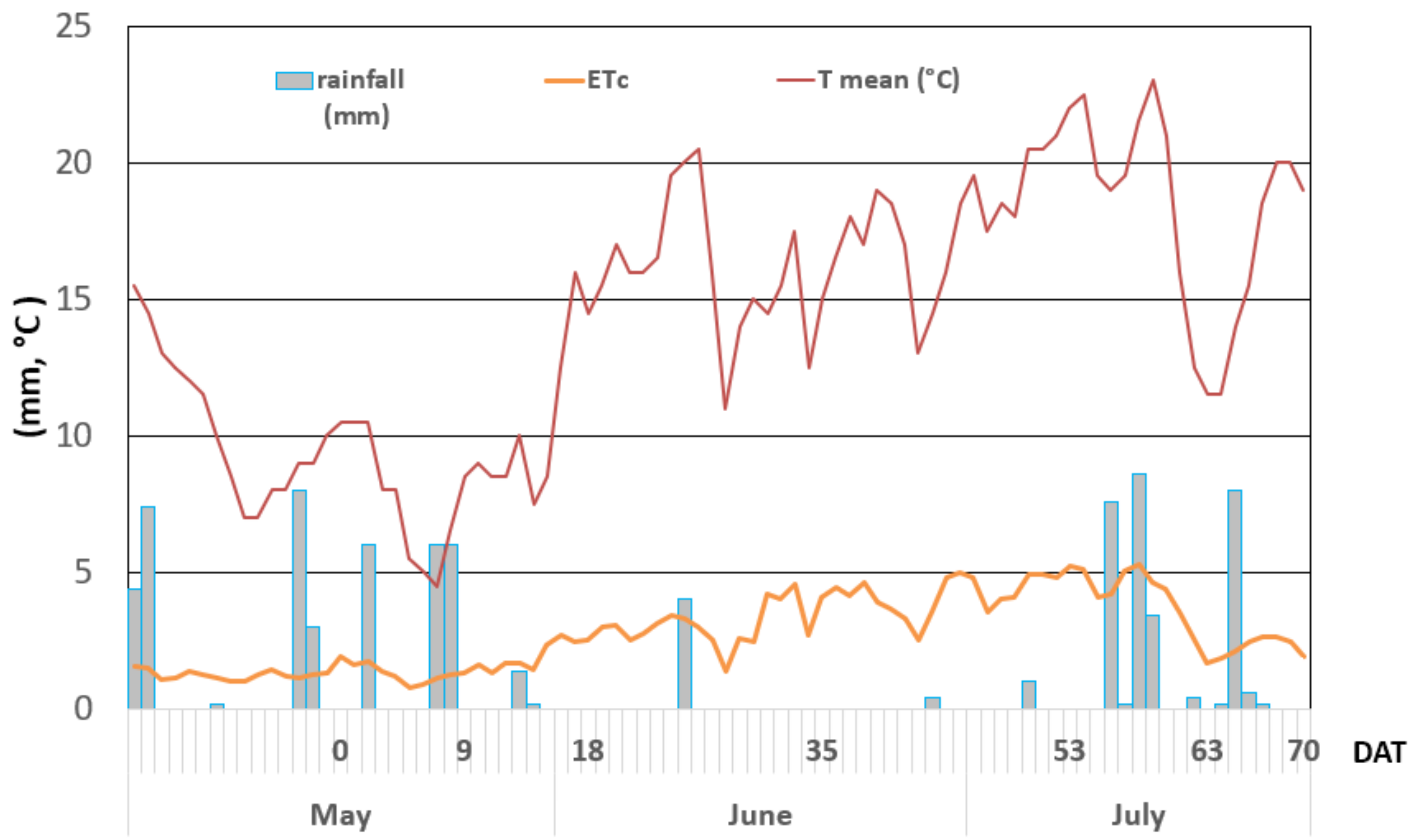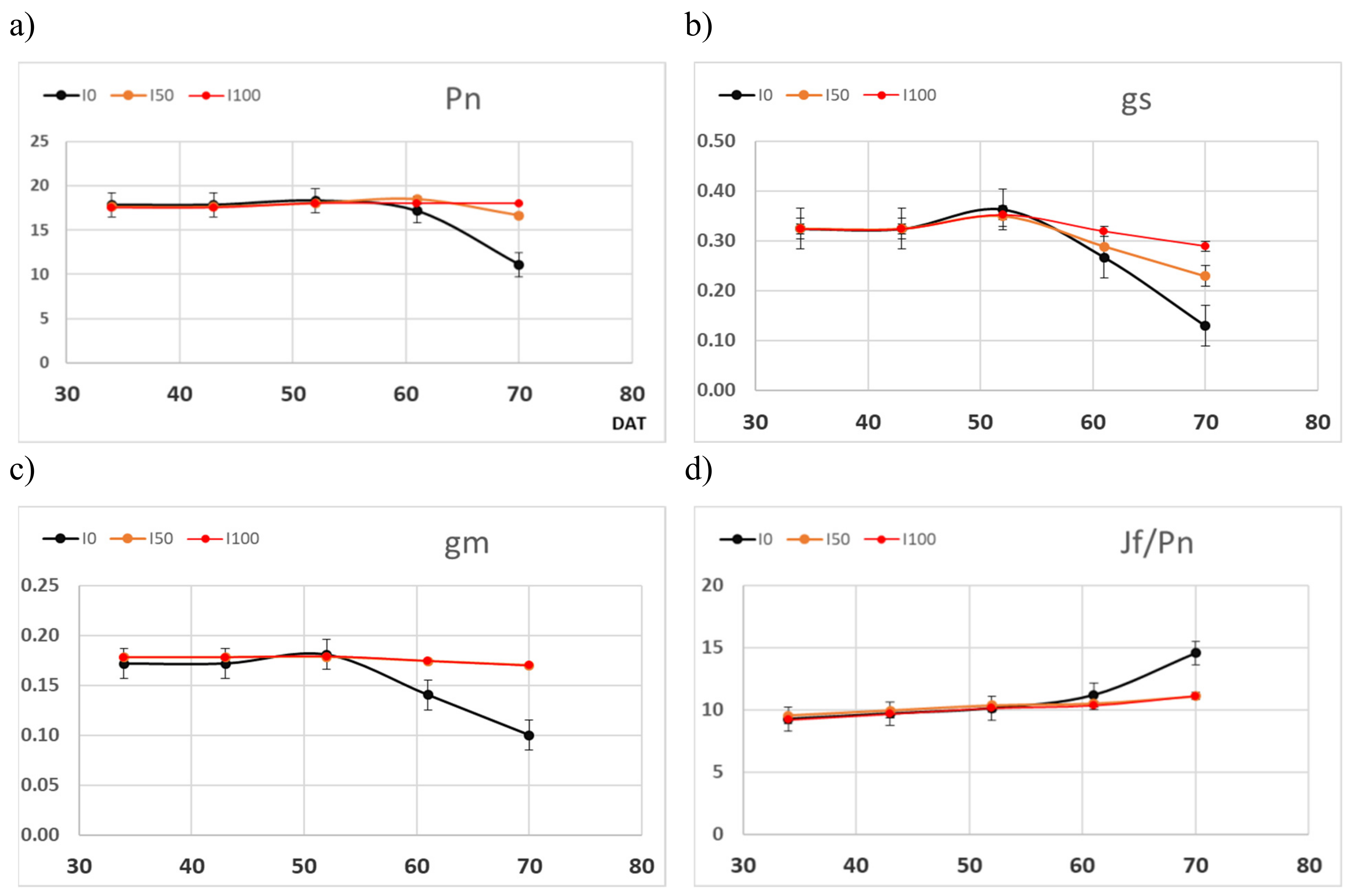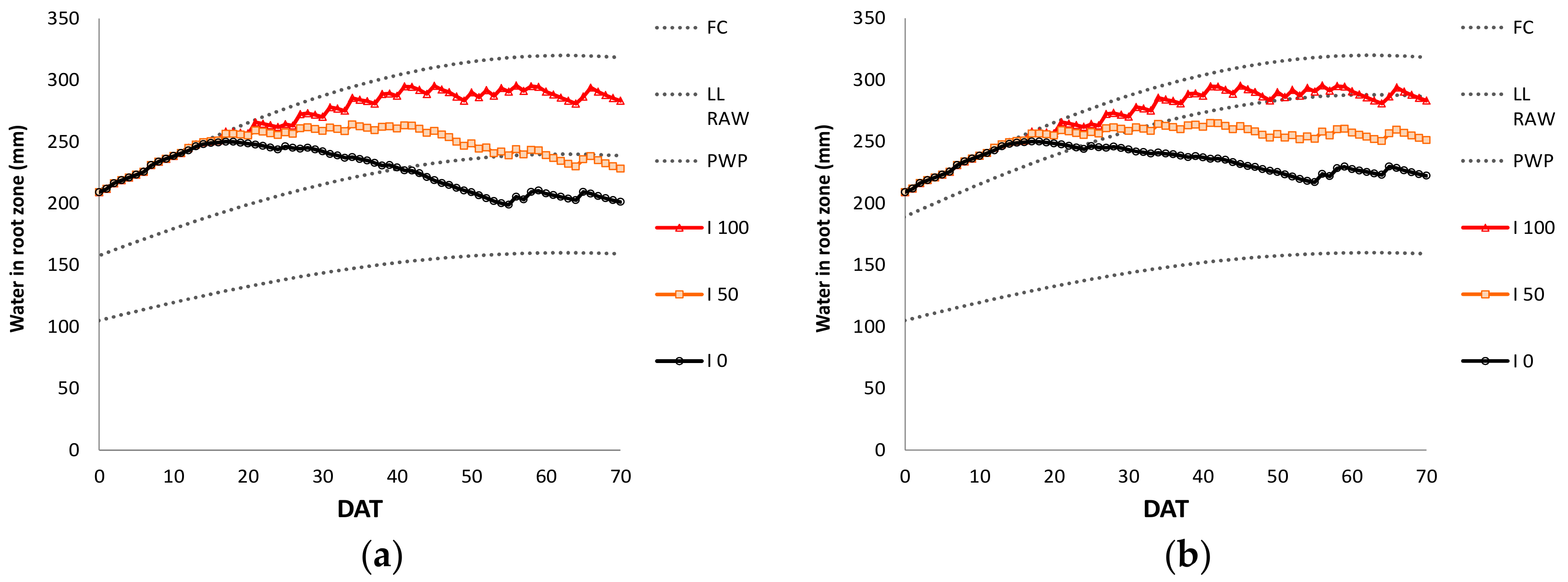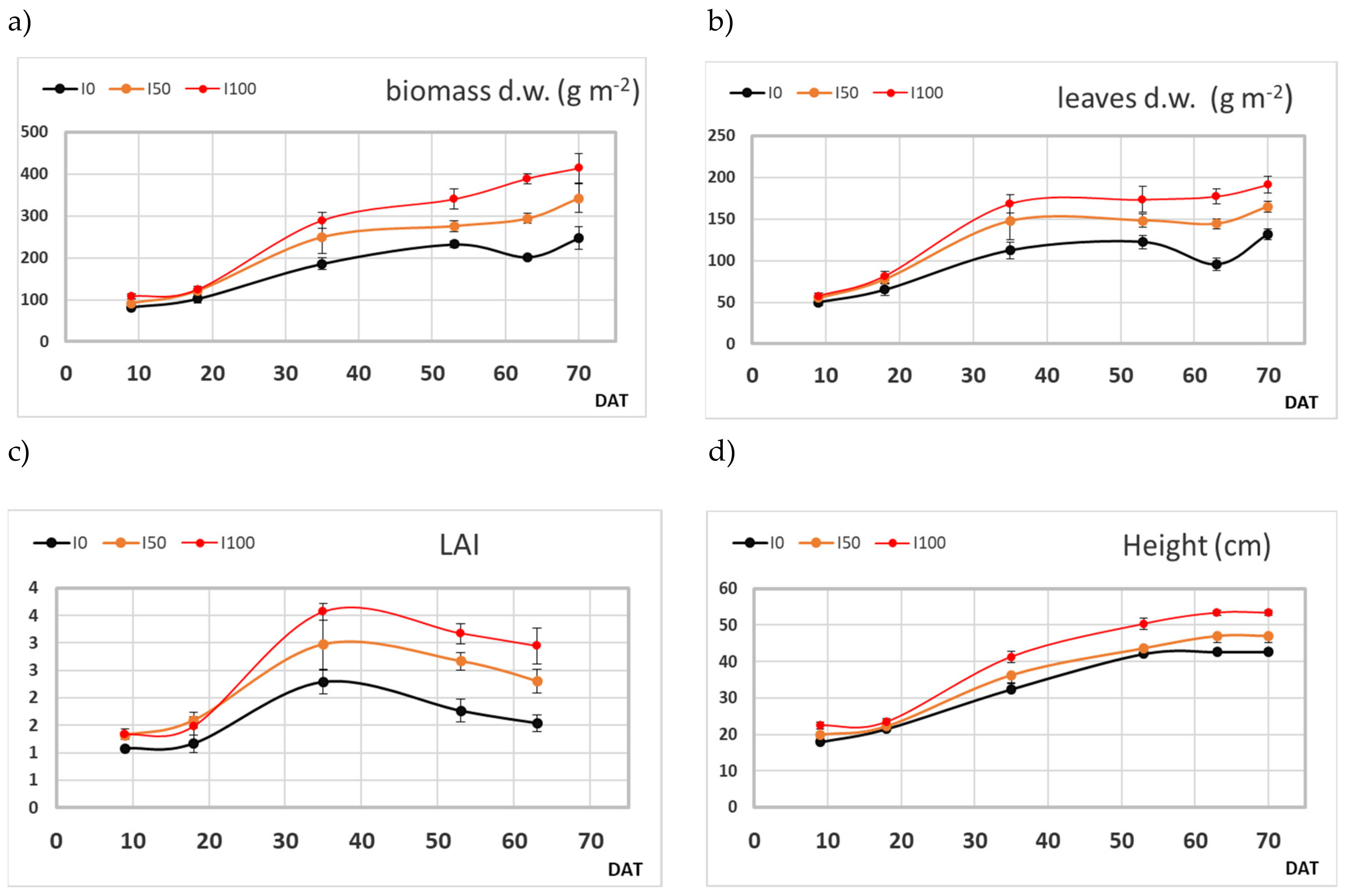Evaluation of the Effect of Irrigation on Biometric Growth, Physiological Response, and Essential Oil of Mentha spicata (L.)
Abstract
:1. Introduction
2. Materials and Methods
2.1. Materials
2.2. Irrigation Treatments and Water Balance
2.3. Agronomic Samplings and Physiological Measurements
2.4. Statistical Analysis
3. Results
3.1. Physiological Measurements
3.2. Soil Water Balance
3.3. Biometric Data
3.4. Organic Compounds
4. Conclusions
Author Contributions
Funding
Conflicts of Interest
Appendix A

References
- Inoue, M.; Craker, L. Medicinal and aromatic plants—uses and functions. Hortic. Pl. People Plac. 2013, 2, 645–669. [Google Scholar] [CrossRef]
- Purohit, S.S.; Vyas, S.P. Marketing of medicinal and aromatic plants in Rajasthan. In Marketing of Medicinal and Aromatic Plants in Rajasthan, National Consultative Workshop on Medicinal Plants; GBPUAT: Pantnagar, India, 2004. [Google Scholar]
- Khan, M.S.A.; Ahmad, I. Herbal Medicine: Current Trends and Future Prospects in Advancements in Herbal Products as Novel Drug Leads; chapter 1, 3-13; Khan, M.S.A., Ahmad, I., Chattopadhyay, D., Eds.; Academic Press: Cambridge, MA, USA, 2019. [Google Scholar] [CrossRef]
- Lawrence, B.M. Mint: The Genus Mentha; Medicinal and Aromatic Plants–Industrial Profiles; CRC Press: Boca Raton, FL, USA, 2006; Volume 1. [Google Scholar]
- Bensabah, F.; Houbairi, S.; Essahli, M.; Lamiri, A.; Naja, J. Chemical composition and inhibitory effect of the essential oil from Mentha spicata irrigated by wastewater on the corrosion of aluminum in 1-molar hydrochloric acid. Port Electrochim. Acta 2013, 31, 195–206. [Google Scholar] [CrossRef]
- Igoumenidis, P.E.; Lekka, E.G.; Karathanos, V.T. Fortification of white milled rice with phytochemicals during cooking in aqueous extract of Mentha spicata leaves. An adsorption studies. LWT-Food Sci. Technol. 2016, 65, 589–596. [Google Scholar] [CrossRef]
- Scherer, R.; Lemos, M.F.; Lemos, M.F.; Martinelli, G.C.; Martins, J.D.L.; da Silva, A.G. Antioxidant and antibacterial activities and composition of Brazilian spearmint (Mentha spicata L.). Ind. Crop Prod. 2013, 50, 408–413. [Google Scholar] [CrossRef]
- Charles, D.J. Antioxidant Properties of Spices, Herbs and Other Source; Frontier Natural Products Co-op: Norway, MI, USA, 2013. [Google Scholar] [CrossRef]
- Tetik, F.; Civelek, S.; Cakilcioglu, U. Traditional uses of some medicinal plants in Malatya (Turkey). J. Ethnopharmacol. 2013, 146, 331–346. [Google Scholar] [CrossRef] [PubMed]
- Kizil, S.; Hasimi, N.; Tolan, V.; Kilinc, E.; Yuksel, U. Mineral content, essential oil components and biological activity of two Mentha species (M. piperita L., M. spicata L.). Turk. J. Field Crop 2010, 15, 148–153. [Google Scholar] [CrossRef]
- Asekun, O.T.; Grierson, D.S.; Afolayan, A.J. Effects of drying methods on the quality and quantity of the essential oil of Mentha longifolia L. subsp. Capensis. Food Chem. 2007, 101, 995–998. [Google Scholar] [CrossRef]
- Mahdavikia, F.; Saharkhiz, M.J.; Karami, A. Defensive response of radish seedlings to the oxidative stress arising from phenolic compounds in the extract of peppermint (Mentha × piperita L.). Sci. Hortic. 2017, 214, 133–140. [Google Scholar] [CrossRef]
- Hanafy, D.M.; Prenzler, P.D.; Burrows, G.E.; Ryan, D.; Nielsen, S.; El Sawi, S.A.; El Alfy, T.S.; Abdelrahman, E.H.; Obied, H.K. Biophenols of mints: Antioxidant, acetyl cholinesterase, butyrylcholin esterase and histone deacetylase inhibition activities targeting alzheimer’s disease treatment. J. Funct. Foods 2017, 33, 345–362. [Google Scholar] [CrossRef]
- Arantes, S.; Piçarra, A.; Candeias, F.; Caldeira, A.T.; Martins, M.R.; Teixeira, D. Antioxidant activity and cholinesterase inhibition studies of four flavoring herbs from Alentejo. Nat. Prod. Res. 2017, 31, 2183–2187. [Google Scholar] [CrossRef]
- Dwivedi, S.; Khan, M.; Srivastava, S.K.; Syamasunnder, K.V.; Srivastava, A. Essential oil composition of different accessions of Mentha × piperita L. grown on the northern plains of India. J. Flav. Frag. 2004, 19, 437–440. [Google Scholar] [CrossRef]
- Chrysargyris, A.; Nikolaidou, E.; Stamatakis, A.; Tzortzakis, N. Vegetative, physiological, nutritional and antioxidant behavior of spearmint (Mentha spicata L.) in response to different nitrogen supply in hydroponics. J. Appl. Res. Med. Arom. Plants 2017, 6, 52–61. [Google Scholar] [CrossRef]
- Figueiredo, A.C.; Barroso, J.G.; Pedro, L.G.; Scheffer, J.J.C. Factors affecting secondary metabolite production in plants: Volatile components and essential oils. J. Flav. Fragr. 2008, 23, 213–226. [Google Scholar] [CrossRef]
- Yazdani, D.; Jamshidi, M.F. Compare of essential oil yield and menthol existent in Peppermint (Mentha piperita L.) planted in different origin of Iran. J. Med. Plant Med. Plant Inst. Jahadda Neshgahi 2002, 3, 73–78. [Google Scholar]
- Aziz, E.A.; Hendawi, S.T.; Azza, E.E.D.; Omer, E.A. Effect of soil type and irrigation intervals on plant growth, essential oil and constituents of Thymus vulgaris plant. Am. Euras. J. Agric. Environ. Sci. 2008, 4, 443–450. [Google Scholar]
- Clark, R.J.; Menary, R.C. Environmental effects on Peppermint (Mentha piperita l.) effects of temperature on photosynthesis, photorespiration and dark respiration in peppermint with reference to oil composition. Austral. J. Pl. Physiol. 2008, 7, 693–697. [Google Scholar] [CrossRef]
- Heidari, F.; Salmasi, S.Z.; Javanshir, A.; Aliari, H.; Dadpoor, M.R. The effects of application microelements and plant density on yield and essential oil of Peppermint (Mentha piperita L.). Iran J. Med. Arom. Plant 2008, 24, 1–9. [Google Scholar]
- Thomas, W.; Ley, M.S.; Stevens, R.G. Mint irrigation management. In Drought Advisory. WSU Prosser Irrigated Agriculture Research and Extension Center; Brian Leib, M.S., Ed.; WSU Cooperative Extension irrigation specialist: Prosser, WA, USA, 2001. [Google Scholar]
- Delfine, S.; Loreto, F.; Pinelli, P.; Tognetti, R.; Alvino, A. Isoprenoids content and photosynthetic limitations in rosemary and spearmint plants under water stress. Agric. Ecosyst. Environ. 2005, 106, 243–252. [Google Scholar] [CrossRef]
- Okwany, R.O.; Peters, R.; Ringer, K.L.; Walsh, D.B. Sustained Deficit Irrigation Effects on Peppermint Yield and Oil Quality in the Semi-Arid Pacific Northwest, USA. Appl. Eng. Agric. 2012, 28, 551–558. [Google Scholar] [CrossRef]
- Okwany, R.O.; Peters, T.R.; Ringer, K.L. Effect of sustained deficit irrigation on hay and oil yield of native spearmint (Mentha spicata). In Proceedings of the Fifth International Conference on Irrigation and Drainage Irrigation for Food, Energy and the Environment, Salt Lake City, UT, USA, 4–7 November 2009; pp. 239–252. [Google Scholar]
- Croteau, R. Effect of irrigation method on essential oil yield and rate of oil evaporation in mint grown under controlled conditions (Mentha piperita, Mentha spicata). Hort. Sci. 1977, 12, 563–565. [Google Scholar]
- Mitchell, A.R.; Yang, C.L. Irrigation of Peppermint for Optimal Yield. Soil Sci. Soc. Am. J. 1998, 62, 1405–1409. [Google Scholar] [CrossRef]
- Nezami, S.; Nemati, S.H.; Aruee, H.; Bagheri, A. Study on effect of water deficit stress on growth of three Mentha species. Environ. Stresses Crop Sci. 2016, 9, 59–74. [Google Scholar]
- Centritto, M.; Loreto, F.; Chartzoulakis, K. The use of low [CO2] to estimate diffusional and non-diffusional limitations of photosynthetic capacity of salt-stressed olive saplings. Plant Cell Environ. 2003, 26, 585–594. [Google Scholar] [CrossRef]
- Asada, K. Radical productions and scavenging in the chloroplasts. In Photosynthesis and the Environment. Advances in Photosynthesis and Respiration; Baker, N.R., Ed.; Springer: Dordrecht, Holland, 1996; Volume 5, pp. 123–150. [Google Scholar] [CrossRef]
- Osmond, B.; Badger, M.; Maxwell, K.; Björkman, O.; Leegood, R. Too many photons: Photorespiration, photoinhibition and photooxidation. Trends Plant Sci. 1997, 2, 119–121. [Google Scholar] [CrossRef]
- Depka, B.; Jahns, P.; Trebst, A. B-Carotene to zeaxanthin conversion in the rapid turnover of D1 protein of photosystem II. FEBS Lett. 1998, 424, 267–270. [Google Scholar] [CrossRef]
- Doorenbos, J.; Pruitt, W.O. Crop Water Requirement: Food and Agriculture Organization of the United Nations; FAO Irrigation and Drainage Paper 24; FAO: Rome, Italy, 1977; Volume 144, pp. 55–65. [Google Scholar]
- Allen, R.G.; Pereira, L.S.; Raes, D.; Smith, M. Crop Evapotranspiration-Guidelines for Computing Crop Water Requirements; FAO Irrigation and drainage paper 56; FAO: Roma, Italy, 1998; Volume 56, p. 300. [Google Scholar]
- Mitchell, A.R. Irrigating Peppermint; EM 8662; Oregon State University: Corvallis, OR, USA, 1997. [Google Scholar]
- Lagos, L.O.; Martin, D.L.; Verma, S.B.; Irmak, S.; Irmak, A.; Eisenhauer, D.; Suyker, A. Surface energy balance model of transpiration from variable canopy cover and evaporation from residue-covered or bare soil systems: Model evaluation. Irri. Sci. 2013, 31, 135–150. [Google Scholar] [CrossRef]
- Flexas, J.; Bota, J.; Loreto, F.; Cornic, G.; Sharkey, T.D. Diffusive and Metabolic Limitations to Photosynthesis under Drought and Salinity in C 3 Plants. Plant Boil. 2004, 6, 269–279. [Google Scholar] [CrossRef]
- Martinelli, T.; Whittaker, A.; Masclaux-Daubresse, C.; Farrant, J.M.; Brilli, F.; Loreto, F.; Vazzana, C. Evidence for the presence of photorespiration in desiccation-sensitive leaves of the C4 ’resurrection’ plant Sporobolus stapfianus during dehydration stress. J. Exp. Bot. 2007, 58, 3929–3939. [Google Scholar] [CrossRef]
- Blanco-Cipollone, F.; Lourenço, S.; Silvestre, J.; Conceição, N.; Moñino, M.J.; Vivas, A.; Ferreira, M.I. Plant Water Status Indicators for Irrigation Scheduling Associated with Iso- and Anisohydric Behavior: Vine and Plum Trees. Horticulturae 2017, 3, 47. [Google Scholar] [CrossRef]
- Limpus, S. Isohydric and Anisodydric Characterisation of Vegetable Crops: The Classification of Vegetables by Their Physiological Responses to Water Stress; Department of Primary Industries and Fisheries: Brisbane, Australia, 2009.
- Gratani, L.; Varone, L. Adaptive photosynthetic strategies of the Mediterranean maquis species according to their origin. Photosynthetica 2004, 42, 551–558. [Google Scholar] [CrossRef]
- Chrysargyris, A.; Papakyriakou, E.; Petropoulos, S.A.; Tzortzakis, N. The combined and single effect of salinity and copper stress on growth and quality of Mentha spicata plants. J. Hazard. Mater. 2019, 368, 584–593. [Google Scholar] [CrossRef] [PubMed]
- Ferreira, M.I. Stress Coefficients for Soil Water Balance Combined with Water Stress Indicators for Irrigation Scheduling of Woody Crops. Horticulturae 2017, 3, 38. [Google Scholar] [CrossRef]
- Doorenbos, J.; Kassam, A.H. Yield Response to Water; Irrigation and Drainage Paper No. 33; FAO: Rome, Italy, 1979; Volume 193, pp. 18–30. [Google Scholar]
- Steduto, P.; Hsiao, T.C.; Raes, D.; Fereres, E. AquaCrop—The FAO Crop Model to Simulate Yield Response to Water: I. Concepts and Underlying Principles. J. Agron. 2009, 101, 426–437. [Google Scholar] [CrossRef]
- Rohloff, J.; Dragland, S.; Mordal, R.; Iversen, T.-H. Effect of Harvest Time and Drying Method on Biomass Production, Essential Oil Yield, and Quality of Peppermint (Mentha×piperitaL.). J. Agric. Food Chem. 2005, 53, 4143–4148. [Google Scholar] [CrossRef]
- Kizil, S.; Tonçer, O. Influence of different harvest times on the yield and oil composition of spearmint (Mentha spicata L. var. spicata). J. Food Agric. Environ. 2006, 4, 135–137. [Google Scholar]
- Mitchell, A.R.; Stevenson, K.; Farris, N.A.; English, M.; Selker, J.S. Irrigation and nitrogen fertility of peppermint in Central Oregon. Coll. Agric. Sci. 1993, 12–21. [Google Scholar]
- Rahimi, Y.; Taleei, A.; Ranjbar, M. Long-term water deficit modulates antioxidant capacity of peppermint (Mentha piperita L.). Sci. Hortic. 2018, 237, 36–43. [Google Scholar] [CrossRef]
- Meskelu, E.; Mohammed, M.; Yimenu, F.; Derese, Y. Spearmint (Mentha spicata L.) response to deficit irrigation. Int. J. Rec. Res. Life Sci. 2014, 1, 22–30. [Google Scholar]
- Alves, L.F.; Bonfim, F.P.G.; De Oliveira, S.G.; Campos, M.G.; Bolina, C.D.O.; Marques, M.O.M. Biomass, content, yield and chemical composition of mint (Mentha x villosa Huds.) essential oil in response to withholding irrigation. Aust. J. Crop. Sci. 2018, 12, 519–523. [Google Scholar] [CrossRef]
- García-Caparrós, P.; Romero, M.J.; Llanderal, A.; Cermeño, P.; Lao, M.T.; Segura, M.L. Effects of Drought Stress on Biomass, Essential Oil Content, Nutritional Parameters, and Costs of Production in Six Lamiaceae Species. Water 2019, 11, 573. [Google Scholar] [CrossRef]
- Chiappero, J.; Cappellari, L.R.; Alderete, L.G.S.; Palermo, T.B.; Banchio, E. Plant growth promoting rhizobacteria improve the antioxidant status in Mentha piperita grown under drought stress leading to an enhancement of plant growth and total phenolic content. Ind. Crops Prod. 2019, 139, 111553. [Google Scholar] [CrossRef]
- Coban, F.; Ozer, H.; Ors, S.; Sahin, U.; Yildiz, G.; Cakmakci, T. Effects of deficit irrigation on essential oil composition and yield of fennel (Foeniculum vulgare M.) in a high-altitude environment. J. Essent. Oil Res. 2018, 30, 457–463. [Google Scholar] [CrossRef]
- Nurzynska-Wierdak, R.; Borowski, B.; Dzida, K.; Zawi´slak, G.; Kowalski, R. Essential oil composition of sweet basil cultivars as affected by nitrogen and potassium fertilization. Turk. J. Agric. Forest. 2013, 37, 427–436. [Google Scholar] [CrossRef]
- Abdi, G.; Shokrpour, M.; Salami, S.A. Essential Oil Composition at Different Plant Growth Development of Peppermint (Mentha x piperita L.) Under Water Deficit Stress. J. Essent. Oil Bear. Plants 2019, 22, 431–440. [Google Scholar] [CrossRef]
- Jirovetz, L.; Buchbauer, G.; Shabi, M.; Ngassoum, M.B. Comparative investigation of essential oil and volatiles of spearmint. Perfum. Flavorist 2002, 27, 16–22. [Google Scholar]
- Kokkini, S.; Karousou, R.; Lanaras, T. Essential oils of spearmint (Carvone-rich) plants from the island of Crete (Greece). Biochem. Syst. Ecol. 1995, 23, 425–430. [Google Scholar] [CrossRef]
- Chauhan, R.; Kaul, M.; Shahi, A.; Kumar, A.; Ram, G.; Tawa, A. Chemical composition of essential oils in Mentha spicata L. accession [IIIM(J)26] from North-West Himalayan region, India. Ind. Crop. Prod. 2009, 29, 654–656. [Google Scholar] [CrossRef]
- Nakawuka, P.; Peters, T.R.; Gallardo, K.R.; Toro-Gonzalez, D.; Okwany, R.O.; Walsh, D.B. Effect of Deficit Irrigation on Yield, Quality, and Costs of the Production of Native Spearmint. J. Irrig. Drain. Eng. 2014, 140, 5014002. [Google Scholar] [CrossRef]
- Khorasaninejad, S.; Mousavi, A.; Soltanloo, H.; Khalighi, A. The effect of drought stress on growth parameters, essential oil yield and constituent of Peppermint (Mentha piperita L.). J. World Appl. Sci. 2011, 5, 5360–5365. [Google Scholar]
- Hassanpour, H.; Khavari-Nejad, R.A.; Niknam, V.; Najafi, F.; Razavi, K. Penconazole induced changes in photosynthesis, ion acquisition and protein profile of Mentha pulegium L. under drought stress. Physiol. Mol. Boil. Plants 2013, 19, 489–498. [Google Scholar] [CrossRef] [Green Version]
- Polanski, L.G.; Khanifar, A.; Tadeusz, W. Effect of salinity and drought stresses on growth parameters, essential oil constituents and yield in peppermint. Afr. J. Agron. 2018, 6, 356–361. [Google Scholar]
- Hassanpour, H.; Khavari-Nejad, R.A.; Niknam, V.; Razavi, K.; Najafi, F. Effect of penconazole and drought stress on the essential oil composition and gene expression of Mentha pulegium L. (Lamiaceae) at flowering stage. Acta Physiol. Plant. 2014, 36, 1167–1175. [Google Scholar] [CrossRef]
- Gershenzon, J. Regulation of Monoterpene Accumulation in Leaves of Peppermint. Plant Physiol. 2000, 122, 205–214. [Google Scholar] [CrossRef] [PubMed] [Green Version]
- Singh, M.K.; Saini, S.S. Planting Date, Mulch, and Herbicide Rate Effects on the Growth, Yield, and Physicochemical Properties of Menthol Mint (Mentha Arvensis). Weed Technol. 2008, 22, 691–698. [Google Scholar] [CrossRef]
- Okwany, R.O.; Peters, T.R.; Ringer, K.L.; Walsh, D.B.; Rubio, M. Impact of sustained deficit irrigation on spearmint (Mentha spicata L.) biomass production, oil yield, and oil quality. Irrig. Sci. 2010, 30, 213–219. [Google Scholar] [CrossRef]
- El-Keltawi, N.E.; Croteau, R. Salinity depression of growth and essential oil formation in spearmint and marjoram and its reversal by foliar applied cytokinin. Phytochemistry 1987, 26, 1333–1334. [Google Scholar] [CrossRef]





| Classes | Tested Essential Oils |
|---|---|
| Alcohol | 3-Octanol, 5-Methyl-3-hexanol, 1-Octen-3-ol |
| Aldehydes | 2-Hexenal, Nonanal |
| Ester | 2-Methylbutyl; 2-Methylbutyrate; cis-3 Hexene valerate |
| Ester Acetate | 2 Methylbutyl 2-methylbutyrate |
| Monoterpene Hydrocarbons | DL-Limonene; β-Myrcene; Sabinene; α-Pinene; β-Pinene, β-trans-Ocimene; β-cis-Ocimene, Camphene; α-Thujene |
| Oxygenated Sesquiterpene | Germacrene D-4-ol, Spathulenol, Caryophyllene oxide, Cubenol, α-Muurolol |
| Sesquiterpene Hydrocarbons | β–Caryophyllene, Germacrene D, α–Bourbonene, β –Elemene, t–Elemene, Carvyl acetate, cis-Jasmone, α–Humulene, β–Cubebene |
| Oxygenated Monoterpenes | Carvone, 1,8-Cineole, trans-Sabinene hydrate, (+)-α-Terpineol, Eugenol, Terpinen-4-ol, cis-Carveol, α-Terpinolene, cis-Sabinene hydrate, Linalool, cis-Limonene oxide, trans-Limonene oxide, cis-Dihydrocarvone, (−)-α-Terpineol, Myrtenol/2-Pinen 10-ol, trans-(+)- Carveol, trans-Carvone oxide, Isopiperitenone, Perillaldehyde, cis-Carvone oxide, p-Mentha-1(7), 8(10)-dien-9-ol / (−)-Perillyl alcohol, Chrysanthenone, Limonene 10-yl-acetate |
| Irrigation Treatments | ETc | Rainfall (mm) | Seasonal Irrigation (mm) | Irrigation Events (number) | Irrigation Depth (mm) |
|---|---|---|---|---|---|
| I0 | 194.3 | 54.2 | 0 | 0 | 0 |
| I50 | 194.3 | 54.2 | 70 | 14 | 5 |
| I100 | 194.3 | 54.2 | 140 | 14 | 10 |
| Irrigation Treatments (I) | DAT (D) | I x D | ||||||
|---|---|---|---|---|---|---|---|---|
| Classes (L ha−1) | I0 | I50 | I100 | p-value | 35 | 70 | p-value | p-value |
| Oxygenated Monoterpenes | 14.5 b | 16.8 b | 22.3 a | *** | 15.5 b | 21.2 a | *** | n.s. |
| Monoterpene hydrocarbons | 2.39 b | 4.713 a | 5.41 a | *** | 2.52 b | 6.49 a | *** | *** |
| Sesquiterpene hydrocarbons | 1.79 b | 3.33 a | 1.91 b | *** | 2.11 b | 2.67 a | * | n.s. |
| Aldehydes | 0.132 bc | 0.161 b | 0.172 a | *** | 0.110 b | 0.217 a | *** | *** |
| Alcohol | 0.093 a | 0.061 b | 0.064 b | *** | 0.058 b | 0.093 a | *** | *** |
| Compounds (L ha−1) | I0 | I50 | I100 | p-value | 35 | 70 | p-value | p-value |
| Carvone | 12.3 c | 14.3 bc | 17.6 a | *** | 12.6 b | 17.7 a | *** | n.s. |
| DL-Limonene | 1.92 b | 3.90 a | 4.44 a | *** | 1.98 b | 5.43 a | *** | *** |
| 1,8-Cineole | 1.31 b | 1.41 b | 3.26 a | *** | 1.74 b | 2.36 a | ** | *** |
| trans-Sabinene hydrate | 0.745 b | 0.892 b | 1.21 a | *** | 0.893 | 1.030 | n.s. | ** |
| β-Caryophylline | 0.478 b | 0.869 a | 0.531 b | *** | 0.512 b | 0.775 a | *** | n.s. |
| Germacrene-D | 0.485 b | 0.995 a | 0.543 b | *** | 0.641 | 0.721 | n.s. | n.s. |
| β-Myrcene | 0.233 b | 0.345 a | 0.397 a | *** | 0.221 b | 0.428 a | *** | n.s. |
| α-Bourbonene | 0.424 b | 0.766 a | 0.456 b | *** | 0.482 b | 0.641 a | ** | * |
| Sabinene | 0.076 c | 0.128 b | 0.205 a | *** | 0.08 b | 0.216 a | *** | *** |
| 2-Hexanal | 0.132 b | 0.161 a | 0.172 a | *** | 0.110 b | 0.217 a | *** | *** |
| β-Elemene | 0.263 b | 0.493 a | 0.257 b | *** | 0.307 b | 0.382 a | * | * |
| α-Pinene | 0.078 b | 0.156 a | 0.133 a | *** | 0.089 b | 0.170 a | *** | *** |
| β-trans-Ocimene | 0.072 b | 0.137 a | 0.138 a | *** | 0.102 b | 0.136 a | *** | n.s. |
| Camphene | 0.009 b | 0.015 b | 0.067 a | *** | 0.016 b | 0.050 a | *** | 0 |
| α-Terpenoel | 0.096 b | 0.139 b | 0.198 a | *** | 0.198 a | 0.069 b | *** | n.s. |
| t-Elemene | 0.135 b | 0.213 a | 0.120 b | *** | 0.159 | 0.151 | n.s. | n.s. |
| 3-Octanol | 0.093 a | 0.061 b | 0.064 b | *** | 0.058 b | 0.093 a | *** | *** |
| Eugenol | 0.184 c | 0.252 b | 0.100 a | *** | 0.152 b | 0.216 a | *** | *** |
| β-cis-Ocimene | 0.024 b | 0.051 a | 0.055 a | *** | 0.035 b | 0.054 a | *** | n.s. |
| Tarpenene-4 ol | 0.086 a | 0.037 b | 0.033 b | *** | 0.012 b | 0.108 a | *** | 0 |
© 2019 by the authors. Licensee MDPI, Basel, Switzerland. This article is an open access article distributed under the terms and conditions of the Creative Commons Attribution (CC BY) license (http://creativecommons.org/licenses/by/4.0/).
Share and Cite
Marino, S.; Ahmad, U.; Ferreira, M.I.; Alvino, A. Evaluation of the Effect of Irrigation on Biometric Growth, Physiological Response, and Essential Oil of Mentha spicata (L.). Water 2019, 11, 2264. https://doi.org/10.3390/w11112264
Marino S, Ahmad U, Ferreira MI, Alvino A. Evaluation of the Effect of Irrigation on Biometric Growth, Physiological Response, and Essential Oil of Mentha spicata (L.). Water. 2019; 11(11):2264. https://doi.org/10.3390/w11112264
Chicago/Turabian StyleMarino, Stefano, Uzair Ahmad, Maria Isabel Ferreira, and Arturo Alvino. 2019. "Evaluation of the Effect of Irrigation on Biometric Growth, Physiological Response, and Essential Oil of Mentha spicata (L.)" Water 11, no. 11: 2264. https://doi.org/10.3390/w11112264
APA StyleMarino, S., Ahmad, U., Ferreira, M. I., & Alvino, A. (2019). Evaluation of the Effect of Irrigation on Biometric Growth, Physiological Response, and Essential Oil of Mentha spicata (L.). Water, 11(11), 2264. https://doi.org/10.3390/w11112264








